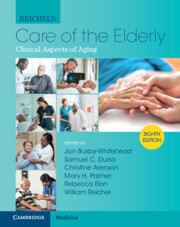Book contents
- Reichel’s Care of the Elderly
- Reichel’s Care of the Elderly
- Copyright page
- In Memoriam
- Contents
- Contributors
- Section I General Approach to the Care of the Elderly
- Section II Geriatric Syndromes
- Chapter 8 Frailty
- Chapter 9 Fall Prevention in Community-Dwelling Older Adults
- Chapter 10 Evaluation and Management of Dizziness
- Chapter 11 Evaluation and Management of Dementia
- Chapter 12 Recognition, Management, and Prevention of Delirium
- Section III Care of the Elderly by Organ System
- Section IV Principles of Care for the Elderly
- Index
- Plate Section (PDF Only)
- References
Chapter 8 - Frailty
from Section II - Geriatric Syndromes
Published online by Cambridge University Press: 30 June 2022
- Reichel’s Care of the Elderly
- Reichel’s Care of the Elderly
- Copyright page
- In Memoriam
- Contents
- Contributors
- Section I General Approach to the Care of the Elderly
- Section II Geriatric Syndromes
- Chapter 8 Frailty
- Chapter 9 Fall Prevention in Community-Dwelling Older Adults
- Chapter 10 Evaluation and Management of Dizziness
- Chapter 11 Evaluation and Management of Dementia
- Chapter 12 Recognition, Management, and Prevention of Delirium
- Section III Care of the Elderly by Organ System
- Section IV Principles of Care for the Elderly
- Index
- Plate Section (PDF Only)
- References
Summary
Frailty is an important geriatric syndrome that is common and commonly missed, and affects more than a third of people over age 85. Frailty is characterized by diminished physiologic reserves and function, leading to decreased capacity to withstand stressors. Frail adults are at a higher risk of dependency, institutionalization, and death. Multiple interventions have been attempted, including physical activity, improving nutrition, and hormonal therapy, but there are no curative interventions for frailty and it is not clear if frailty can be reversed. Several issues have limited the advancement of frailty research and translation into practice, including the lack of consensus regarding the definition of frailty, the proliferation of assessment tools, and the gaps in validated best practice guidance for frail patients. The recognition of frailty, especially in its early stages, offers the possibility of preventing or mitigating adverse clinical outcomes. Older adults who are frail may benefit most from a comprehensive geriatric evaluation to help elucidate a plan of care that is consistent with patient's goals, values, and preferences.
- Type
- Chapter
- Information
- Reichel's Care of the ElderlyClinical Aspects of Aging, pp. 81 - 90Publisher: Cambridge University PressPrint publication year: 2022



